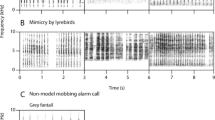Abstract
Males of many animal species mimic females, and thereby deceive rival males. Facultative shifts in posture, color, or movement allow a male using visually-based mimicry to adopt and terminate mimicry rapidly. Pheromonal mimicry is rare in vertebrates perhaps because it is difficult to redeploy pheromones rapidly enough to adjust male tactics to local conditions. In Manitoba garter snakes (Thamnophis sirtalis parietalis), female mimicry benefits males immediately after they have emerged from hibernation. While the snakes are cold and slow, courtship warms them and protects them against predatory crows. This benefit disappears as soon as the snakes are warm. We show that (unlike females) she-male garter snakes attract courting males only when they are cold. Low temperatures may suppress volatility of “less attractive” components of the pheromones (saturated methyl ketones) that she-males use to attract courtship, allowing male snakes to function as transvestites only when this tactic is beneficial.

Similar content being viewed by others
References
Andersson M (1994) Sexual selection. Princeton University Press, Princeton
Brower LP (1988) Mimicry and the evolutionary process. University of Chicago Press, Chicago
Cardé RT, Bel WJ (1995) Chemical ecology of insects 2. Springer, Berlin
Gregory PT, Stewart KW (1975) Long-distance dispersal and feeding strategy of the red-sided garter snake (Thamnophis sirtalis parietalis) in the Interlake of Manitoba. Can J Zool 53:238–245
Gunstone FD (1996) Fatty acid and lipid chemistry. Blackie Academic, Glasgow
Hanlon RT, Naud M-J, Shaw PW, Havenhand JN (2005) Transient sexual mimicry leads to fertilisation. Nature 430:212
Korzan WJ, Robison RR, Zhao S, Fernald RD (2008) Color change as a potential behavioral strategy. Horm Behav 54:463–470
LeMaster MP, Stefani A, Shine R, Mason RT (2008) Cross-dressing in chemical cues: exploring ‘she-maleness’ in newly-emerged male garter snakes. In: Hurst JL, Beynon RJ, Roberts SC, Wyatt TD (eds) Chemical signals in vertebrates 11. Springer, New York, pp 223–230
Maderson PFA (1986) Tetrapod epidermis: a system protoadapted as a semiochemical source. In: Duvall D, Muller-Schwarze D, Silverstein RM (eds) Chemical signals in vertebrates 4. Ecology, evolution and comparative biology. Plenum, New York, pp 13–26
Mason RT, Crews D (1985) Female mimicry in garter snakes. Nature 316:59–60
Mason RT, Parker MR (2010) Social behavior and pheromonal communication in reptiles. J Comp Physiol A 196:729–749
Moore IT, Mason RT (2001) Behavioral and hormonal responses to corticosterone in the male red-sided garter snake, Thamnophis sirtalis parietalis. Physiol Behav 72:669–674
Peschke K (1987) Male aggression, female mimicry and female choice in the rove beetle, Aleochara curtula (Coleoptera, Staphylinidae). Ethology 75:265–284
Pfrender M, Mason RT, Wilmslow JT, Shine R (2001) Thamnophis sirtalis parietalis (red-sided gartersnake). Male-male copulation. Herpetol Rev 32:52
Shine R, Mason RT (2001) Courting male garter snakes use multiple cues to identify potential mates. Behav Ecol Sociobiol 49:465–473
Shine R, Harlow P, LeMaster MP, Moore IT, Mason RT (2000a) The transvestite serpent: why do male garter snakes court (some) other males? Anim Behav 59:349–359
Shine R, O'Connor D, Mason RT (2000b) Female mimicry in garter snakes: behavioural tactics of “she-males” and the males that court them. Can J Zool 78:1391–1396
Shine R, Olsson MM, LeMaster MP, Moore IT, Mason RT (2000c) Effects of sex, body size, temperature and location on the antipredator tactics of free-ranging gartersnakes (Thamnophis sirtalis, Colubridae). Behav Ecol 11:239–245
Shine R, Olsson MM, Mason RT (2000d) Chastity belts in gartersnakes: the functional significance of mating plugs. Biol J Linn Soc 70:377–390
Shine R, LeMaster MP, Moore IT, Olsson MM, Mason RT (2001a) Bumpus in the snake den: effects of sex, size and body condition on mortality in red-sided garter snakes. Evolution 55:598–604
Shine R, Phillips B, Waye H, LeMaster M, Mason RT (2001b) Benefits of female mimicry in snakes. Nature 414:267
Shine R, Elphick MJ, Harlow PS, Moore IT, LeMaster MP, Mason RT (2001c) Movements, mating and dispersal of red-sided gartersnakes from a communal den in Manitoba. Copeia 2001:82–91
Shine R, Langkilde T, Mason RT (2003a) Cryptic forcible insemination: male snakes exploit female physiology, anatomy and behavior to obtain coercive matings. Am Nat 162:653–667
Shine R, Phillips B, Waye H, LeMaster M, Mason RT (2003b) Chemosensory cues allow courting male garter snakes to assess body length and body condition of potential mates. Behav Ecol Sociobiol 54:162–166
Shine R, Wall M, Langkilde T, Mason RT (2005) Battle of the sexes: forcibly-inseminating male garter snakes target courtship to more vulnerable females. Anim Behav 70:1133–1140
Shine R, Langkilde T, Wall M, Mason RT (2006) Temporal dynamics of emergence and dispersal of garter snakes from a communal den in Manitoba. Wildl Res 33:103–111
Vereecken NJ, McNeil JN (2010) Cheaters and liars: chemical mimicry at its finest. Can J Zool 88:725–752
Whiting MJ, Webb JK, Keogh JS (2009) Flat lizard female mimics use sexual deception in visual but not chemical signals. Proc R Soc B 276:1585–1591
Whittier JM, Mason RT, Crews D (1985) Mating in the red-sided gartersnake, Thamnophis sirtalis parietalis: differential effects on male and female sexual behavior. Behav Ecol Sociobiol 16:257–261
Acknowledgments
We thank Mike Wall and the Johnson family for assistance and the Australian Research Council for funding.
Ethical standards
All experiments reported in this paper comply with the current laws of the country in which they were performed.
Author information
Authors and Affiliations
Corresponding author
Additional information
Communicated by T. Breithaupt
Rights and permissions
About this article
Cite this article
Shine, R., Langkilde, T. & Mason, R.T. Facultative pheromonal mimicry in snakes: “she-males” attract courtship only when it is useful. Behav Ecol Sociobiol 66, 691–695 (2012). https://doi.org/10.1007/s00265-012-1317-4
Received:
Revised:
Accepted:
Published:
Issue Date:
DOI: https://doi.org/10.1007/s00265-012-1317-4




